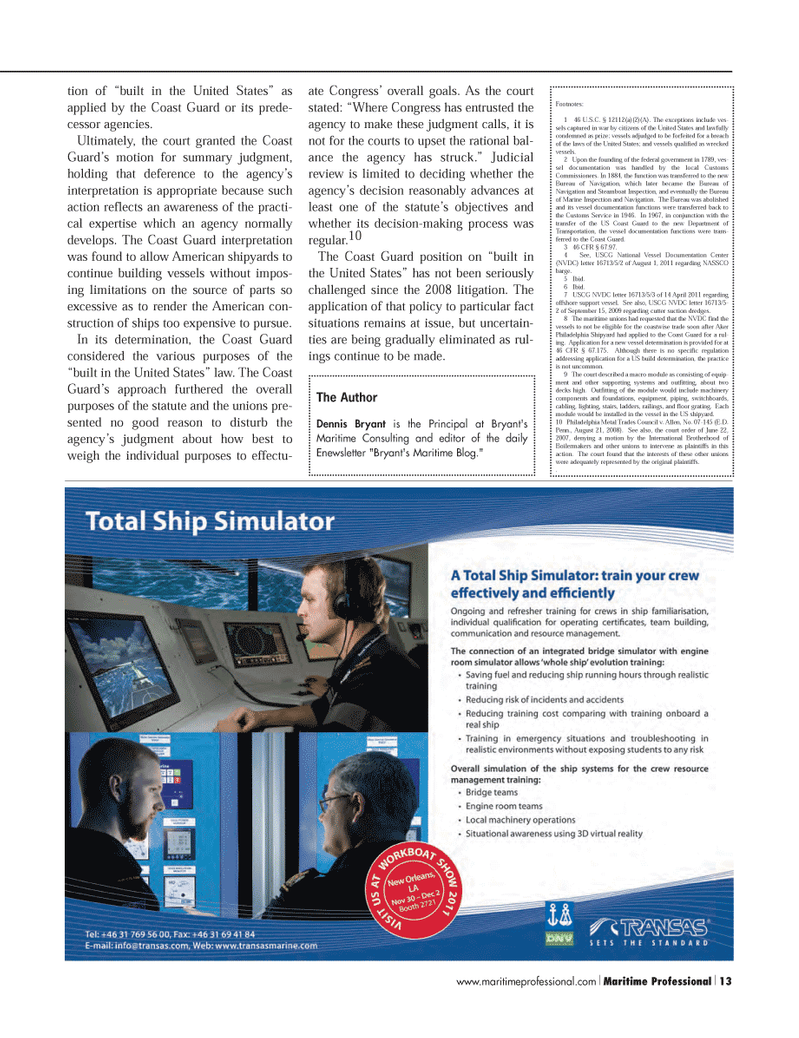
Page 13: of Maritime Logistics Professional Magazine (Q4 2011)
Classification
Read this page in Pdf, Flash or Html5 edition of Q4 2011 Maritime Logistics Professional Magazine
www.maritimeprofessional.com Maritime Professional 13 tion of ?built in the United States? as applied by the Coast Guard or its prede-cessor agencies. Ultimately, the court granted the Coast Guard?s motion for summary judgment, holding that deference to the agency?s interpretation is appropriate because suchaction reflects an awareness of the practi- cal expertise which an agency normally develops. The Coast Guard interpretation was found to allow American shipyards to continue building vessels without impos- ing limitations on the source of parts soexcessive as to render the American con- struction of ships too expensive to pursue. In its determination, the Coast Guardconsidered the various purposes of the ?built in the United States? law. The Coast Guard?s approach furthered the overall purposes of the statute and the unions pre-sented no good reason to disturb theagency?s judgment about how best to weigh the individual purposes to effectu- ate Congress? overall goals. As the court stated: ?Where Congress has entrusted theagency to make these judgment calls, it is not for the courts to upset the rational bal-ance the agency has struck.? Judicial review is limited to deciding whether the agency?s decision reasonably advances at least one of the statute?s objectives and whether its decision-making process was regular. 10The Coast Guard position on ?built in the United States? has not been seriouslychallenged since the 2008 litigation. The application of that policy to particular fact situations remains at issue, but uncertain- ties are being gradually eliminated as rul-ings continue to be made.The AuthorDennis Bryant is the Principal at Bryant's Maritime Consulting and editor of the dailyEnewsletter "Bryant's Maritime Blog." Footnotes: 1 46 U.S.C. § 12112(a)(2)(A). The exceptions include ves- sels captured in war by citizens of the United States and lawfully condemned as prize; vessels adjudged to be forfeited for a breach of the laws of the United States; and vessels qualified as wrecked vessels. 2 Upon the founding of the federal government in 1789, ves- sel documentation was handled by the local Customs Commissioners. In 1884, the function was transferred to the new Bureau of Navigation, which later became the Bureau of Navigation and Steamboat Inspection, and eventually the Bureau of Marine Inspection and Navigation. The Bureau was abolished and its vessel documentation functions were transferred back to the Customs Service in 1946. In 1967, in conjunction with thetransfer of the US Coast Guard to the new Department of Transportation, the vessel documentation functions were trans- ferred to the Coast Guard.3 46 CFR § 67.97.4 See, USCG National Vessel Documentation Center (NVDC) letter 16713/5/2 of August 1, 2011 regarding NASSCO barge. 5 Ibid.6 Ibid.7 USCG NVDC letter 16713/5/3 of 14 April 2011 regarding offshore support vessel. See also, USCG NVDC letter 16713/5- 2 of September 15, 2009 regarding cutter suction dredges. 8 The maritime unions had requested that the NVDC find the vessels to not be eligible for the coastwise trade soon after Aker Philadelphia Shipyard had applied to the Coast Guard for a rul- ing. Application for a new vessel determination is provided for at 46 CFR § 67.175. Although there is no specific regulation addressing application for a US build determination, the practice is not uncommon. 9 The court described a macro module as consisting of equip- ment and other supporting systems and outfitting, about two decks high. Outfitting of the module would include machinery components and foundations, equipment, piping, switchboards,cabling, lighting, stairs, ladders, railings, and floor grating. Eachmodule would be installed in the vessel in the US shipyard. 10 Philadelphia Metal Trades Council v. Allen, No. 07-145 (E.D. Penn., August 21, 2008). See also, the court order of June 22, 2007, denying a motion by the International Brotherhood of Boilermakers and other unions to intervene as plaintiffs in this action. The court found that the interests of these other unions were adequately represented by the original plaintiffs. .MP #4 (1-17):MP Layouts 11/7/2011 4:57 PM Page 13

 12
12

 14
14
